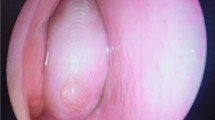Abstract
Introduction
Solitary fibrous tumors are mesenchymally derived masses most commonly originating from the lung pleura.
Case report
Herein, we report a 6-month-old presenting with syndrome of inappropriate antidiuretic hormone secretion (SIADH) and a suprasellar mass. The mass proved to be a solitary fibrous tumor. This case and salient literature are reviewed.
Conclusions
To our knowledge, this is the youngest patient to be described with a mass of this type within the central nervous system.


Similar content being viewed by others
References
Robinson LA (2006) Solitary fibrous tumor of the pleura. Cancer Control : J Moffitt Cancer Center 13(4):264–269
Brunnemann RB, Ro JY, Ordonez NG, Mooney J, El-Naggar AK, Ayala AG (1999) Extrapleural solitary fibrous tumor: a clinicopathologic study of 24 cases. Mod Pathol 12(11):1034–1042
Carneiro SS, Scheithauer BW, Nascimento AG, Hirose T, Davis DH (1996) Solitary fibrous tumor of the meninges: a lesion distinct from fibrous meningioma. A clinicopathologic and immunohistochemical study. Am J Clin Pathol 106(2):217–224
Ritz R, Roser F, Bornemann A, Merkle M, Freudenstein D (2005) Recurrence and increased proliferation rate of a solitary fibrous tumor in the central nervous system–case report and review of the literature. Clin Neuropathol 24(6):252–256
Alapatt JP, Ajaya KA, Govindan A, Rajeev MP, Radhakrishnan M (2012) Solitary fibrous tumor of the tentorium: a case report. Turk Neurosurg 22(4):454–457
Louis DN, Ohgaki H, Wiestler OD, Cavenee WK, Burger PC, Jouvet A, Scheithauer BW, Kleihues P (2007) The 2007 WHO classification of tumours of the central nervous system. Acta Neuropathol 114(2):97–109
Cummings TJ, Burchette JL, McLendon RE (2001) CD34 and dural fibroblasts: the relationship to solitary fibrous tumor and meningioma. Acta Neuropathol 102(4):349–354
Caroli E, Salvati M, Orlando ER, Lenzi J, Santoro A, Giangaspero F (2004) Solitary fibrous tumors of the meninges: report of four cases and literature review. Neurosurg Rev 27(4):246–251
Bisceglia M, Galliani C, Giannatempo G, Lauriola W, Bianco M, D’angelo V, et al (2011) Solitary fibrous tumor of the central nervous system: a 15-year literature survey of 220 cases. Adv Anat Pathol 18(5):356–392
Tihan T, Viglione M, Rosenblum MK, Olivi A, Burger PC (2003) Solitary fibrous tumors in the central nervous system. A clinicopathologic review of 18 cases and comparison to meningeal hemangiopericytomas. Arch Pathol Lab Med 127(4):432–439
Ahn JY, Shim JY, Yang WI, Kim TS (2001) Meningeal solitary fibrous tumor as an unusual cause of exophthalmos: case report and review of the literature. Neurosurgery 48(6):1362–1366
Rodriguez F, Scheithauer BW, Ockner DM, Giannini C (2004) Solitary fibrous tumor of the cerebellopontine angle with salivary gland heterotopia: a unique presentation. Am J Surg Pathol 28(1):139–142
Surendrababu NR, Chacko G, Daniel RT, Chacko AG (2006) Solitary fibrous tumor of the lateral ventricle: CT appearances and pathologic correlation with follow-up. AJNR Am J Neuroradiol 27(10):2135–2136
Kasper E, Boruchow S, Lam FC, Zinn PO, Anderson M, Mahadevan A (2012) “Hitting all the right markers to save a life” Solitary fibrous tumors of the central nervous system: case series and review of the literature. Surg Neurol Int 3:83
Mordani JP, Haq IU, Singh J (2000) Solitary fibrous tumour of the spinal cord. Neuroradiology 42(9):679–681
Suzuki SO, Fukui M, Nishio S, Iwaki T (2000) Clinicopathological features of solitary fibrous tumor of the meninges: an immunohistochemical reappraisal of cases previously diagnosed to be fibrous meningioma or hemangiopericytoma. Pathol Int 50(10):808–817
Cox DP, Daniels T, Jordan RC (2010) Solitary fibrous tumor of the head and neck. Oral Surg Oral Med Oral Pathol Oral Radiol Endod 110(1):79–84
Challa VR, Kilpatrick SE, Ricci P, Wilson JA, Kelly DL Jr (1998) Solitary fibrous tumor of the meninges. Clin Neuropathol 17(2):73–78
Macfarlane RG, Galloway M, Plowman PN, Thomas DG (2005) A highly vascular intracranial solitary fibrous tumor treated with radiotherapy and toremifene: case report. Neurosurgery 56(6), E1378, discussion E1378
Nakahara K, Yamada M, Shimizu S, Fujii K (2006) Stereotactic radiosurgery as adjuvant treatment for residual solitary fibrous tumor: case report. J Neurosurg 105(5):775–776
Kaplan SS, Ojemann JG, Grange DK, Fuller C, Park TS (2002) Intracranial infantile myofibromatosis with intraparenchymal involvement. Pediatr Neurosurg 36(4):214–217
Hori E, Kurimoto M, Fukuda O, Takahashi C, Nagai S, Oya T, Endo S (2007) Recurrent intracranial solitary fibrous tumor initially diagnosed as hemangiopericytoma. Brain Tumor Pathol 24(1):31–34
Miyashita K, Hayashi Y, Fujisawa H, Hasegawa M, Yamashita J (2004) Recurrent intracranial solitary fibrous tumor with cerebrospinal fluid dissemination. Case report. J Neurosurg 101(6):1045–1048
Conflict of interest
The authors have no conflicts of interest to report.
Author information
Authors and Affiliations
Corresponding author
Rights and permissions
About this article
Cite this article
Rubacha, M., Tubbs, R.S., Li, R. et al. Pediatric central nervous system solitary fibrous tumor: case report. Childs Nerv Syst 31, 2379–2381 (2015). https://doi.org/10.1007/s00381-015-2761-z
Received:
Accepted:
Published:
Issue Date:
DOI: https://doi.org/10.1007/s00381-015-2761-z




